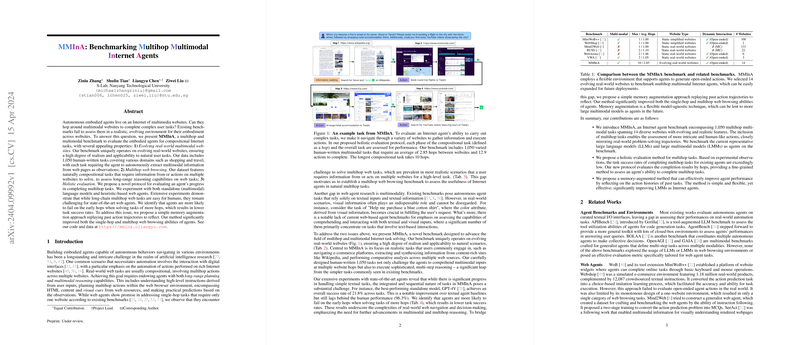Evaluating Embodied Agents in Multihop, Multimodal Web Environments with MMInA
Introduction
The exploration of autonomous agents' capability to navigate and perform tasks in a multihop, multimodal web environment forms a critical juncture in AI research, particularly in the domain of Internet agents. The presented paper introduces MMInA, a new benchmark tailored for evaluating these agents' effectiveness in executing compositional Internet tasks across evolving real-world websites. This benchmark focuses on the agents' ability to interpret and act upon multimodal inputs (text and images) across multiple hops, necessitating advanced reasoning, planning, and execution over a series of interconnected web-based tasks.
Benchmark Design
MMInA goes beyond existing benchmarks by providing a realistic and challenging environment for agents, highlighted by three distinguishing features:
- Evolving Real-World Websites: MMInA is grounded in the evolving landscape of real-world websites, increasing the benchmark's relevance and difficulty by presenting agents with up-to-date challenges reflective of actual user tasks.
- Multihop Browsing: The benchmark comprises tasks that demand navigation and action across multiple websites, thus evaluating the agents' long-range reasoning and planning capabilities.
- Holistic Evaluation: A novel evaluation protocol assesses agent performance across each phase of a multihop task, providing insights into the step-wise effectiveness and efficiency in task execution.
Multimodal Web Content and Multihop Design
MMInA explicitly addresses the challenges of multimodal web navigation by including tasks that necessitate the processing of both textual and visual web content. The benchmark comprises 1,050 tasks, simulated across 14 diverse websites, requiring agents to perform an average of 2.85 hops and execute 12.9 actions to complete tasks. This multihop, multimodal setup pushes the boundaries of current agent capabilities by assessing their performance in a complex, real-world akin scenario.
Experimental Insights
The extensive experimentation with state-of-the-art agents underscored the current limitations in solving multihop web tasks, highlighting a substantial performance gap compared to human benchmarks. Notably, standalone models like GPT-4V showed promising yet insufficient success rates, indicating the need for improved models capable of navigating the nuanced, multifaceted web environment MMInA presents.
Memory-augmented Agents
The research introduces a memory augmentation approach to enhance agent performance, a novel stride towards addressing the complex nature of multihop tasks. This method significantly improves both single-hop and multihop browsing capabilities by leveraging past action trajectories as a reflective mechanism, enabling agents to learn from previous interactions and adjust their strategies more effectively.
Implications and Future Directions
The findings from MMInA benchmarking reveal crucial insights into the challenges faced by current web agents in executing realistic, compositional tasks on the Internet. The demonstrated need for enhanced multimodal reasoning and memory mechanisms indicates significant opportunities for future research. The introduction of memory-augmented agents suggests a promising direction towards developing more proficient models capable of addressing the complexities inherent in real-world web navigation and task execution.
In conclusion, MMInA represents a pivotal step forward in the evaluation and development of autonomous agents for the web, providing a robust framework for assessing and enhancing their capabilities in a realistic, challenging, and ever-changing environment. The future development of AI agents, bolstered by advancements in multimodal understanding, memory augmentation, and adaptive reasoning, will undoubtedly herald a new era of autonomous Internet navigation and task completion.
